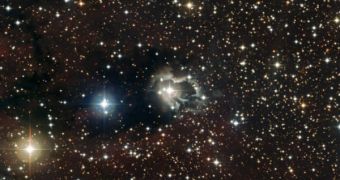A peculiar star system, that astronomers named HD 87643, has recently been imaged as being involved in creating its own nebula. The cosmic formation is believed to be generated by the vast amounts of gas that the star at the center of the system emits, which is trapped in its general vicinity. In charge of the new observations were astronomers at the European Southern Observatory (ESO), who noticed the peculiar cosmic formation in the direction of the Carina Constellation containing the giant Eta Carinae Nebula (NGC 3372), as well as the second brightest star in the night sky, Canopus.
According to detailed investigations conducted at ESO, it may be that HD 87643 is not working on creating its nebula alone. Telescope data have revealed that the giant star is tidally locked with a smaller one, and astronomers infer that the violent interactions that occur between the two globes of fire are the main trigger that ejects gas in the system's surrounding. This would make the formation a binary star system that, every 15 to 20 years, releases tension between its components by emitting vast amounts of gas, Wired reports.
The most likely explanation on why these cycles occur could be the fact that the orbits in which the stars rotate around each other may, at these intervals, come too close to each other. Astronomers cannot even begin to imagine the complexity of the interactions that occur during such an event. Solar winds, plasma eruptions and radiations all collide head-on, probably giving birth to new states of matter and exotic radiation. After the “clash” is done, it may be that the cooling gas that resulted is pushed away by violent solar winds, but remains in the general neighborhood, giving the star system its hood-like appearance (visible at the center of the image).
The Carina Constellation is home to a large number of popular cosmic objects. In addition to the aforementioned two, it also features the open clusters NGC 2516 (the Diamond Cluster) and IC 2602, also known as Theta Carinae Cluster or, more commonly, the Southern Pleiades. The latter, despite being more than 479 light-years away from the Earth, can be seen by the human eye, especially from the Southern Hemisphere. These open clusters have appeared as a result of the fact that the Milky Way runs directly through Carina.

 14 DAY TRIAL //
14 DAY TRIAL //